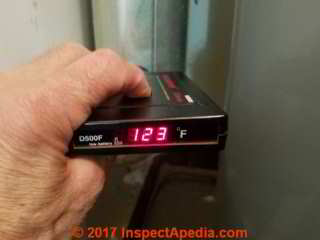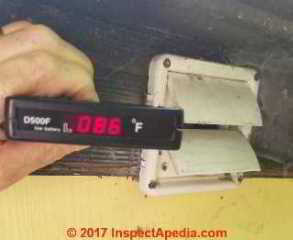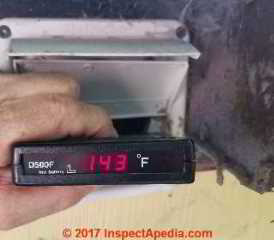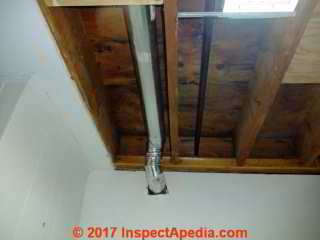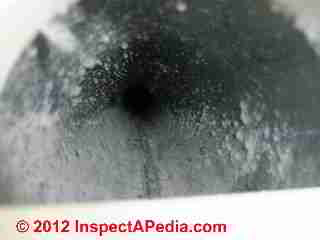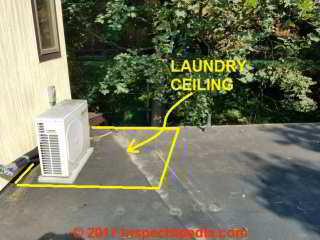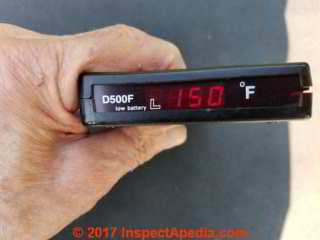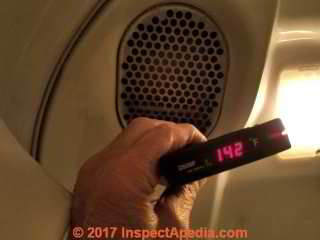 Dryer & Dryer Vent Temperature Measurements
Dryer & Dryer Vent Temperature Measurements
Field Measurement of Temperatures in a Clothes Dryer & its Vent
- POST a QUESTION or COMMENT about clothes dryer operating, heater & vent temperatures vs fire safety
Clothes dryer temperature measurements:
This article describes field measurements of a gas powered clothes dryer temperatures in the dryer and in its exhaust vent system.
This article series on clothes dryer temperatures gives the normal operating temperature at different points inside the clothes dryer appliance and its venting system. We include also unsafe temperatures that might be reached during various dryer faults or conditions and temperatures that could cause a dryer fire.
Page top image: the author [DF] measuring the approximate surface temperature of the hot air inlet of a Maytag LP gas fueled residential clothes dryer. With the dryer heat set to high and the gas burner on and stabilized the temperature was approximately 140 °F (60 °C).
InspectAPedia tolerates no conflicts of interest. We have no relationship with advertisers, products, or services discussed at this website.
Gas Clothes Dryer Actual Temperature Measurements
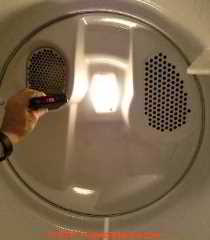 In July 2017, using an Exergen infrared thermometer I [DF] measured surface temperatures at key locations inside of a recent (2015) model Maytag Model MGDC21EW1 LP gas fueled clothes dryer installed in a home in Poughkeepsie, NY in May 2016.
In July 2017, using an Exergen infrared thermometer I [DF] measured surface temperatures at key locations inside of a recent (2015) model Maytag Model MGDC21EW1 LP gas fueled clothes dryer installed in a home in Poughkeepsie, NY in May 2016.
I also measured the aluminum clothes dryer exhaust vent pipe surface temperatures at an indoor location close to the dryer exhaust outlet and outdoors inside of the metal dryer vent at the dryer vent screen.
[Click to enlarge any image]
Gas Dryer Temperature Measurement Conditions
- Measurements made at 4PM on 17 July 2017. Weather was hot and sunny.
- Estimated flat-roof cavity temperature - passage of the dryer exhaust vent (approximately 3 m) - 100 °F (38 °C)
- Approximate indoor ambient temperature - 72 °F (22°C)
- Approximate outdoor ambient temperature - 86 °F (30 °C)
- The dryer heat setting to HIGH
- The dryer in operation for at least ten minutes before measurements
- The gas burner was cycled on during measurements except for screening measurements made to demonstrate that the exhaust temperature falls whenever the gas burner cycles off
- For one temperature measurement close to the dryer vent attachment point, the surface measurement spot on the metal dryer vent was colored with black magic marker
- All other temperature measurements were made as close as possible to the measured surface but without having colored-black the measurement point
- The dryer tumbler drum was empty during these measurements - effects of wet clothing normally in a clothes dryer early in its cycle will not be shown but this measurement condition should be similar to clothes dryer temperatures at the end of a clothing-filled clothes dryer cycle.
Field Measurements of Clothes Dryer Operating Temperatures |
||
| Measurement Location | Temperature | Comments |
| Dryer interior / surface temperatures, gas burner ON | ||
| dryer tumbler drum surface | 128 °F (53 °C)1 | Dryer temperature set on HIGH, empty of clothing, stable temperature (Day 1) |
| hot air inlet to the dryer tumbler drum | 142 °F (61 °C)1 | same as above |
| hot air exhaust port | 137 °F (58 °C)1 | same as above |
| dryer front access door surface | 103 °F (39 °C)2 | Dryer temperature set on MEDIUM, normal load of clothing, stable temperature (Day 2) |
| Dryer exhaust vent surface temperatures, gas burner ON | ||
| Metal vent pipe surface 8" from dryer's rear exhaust port | 123 °F (51 °C)1 | Dryer set on HIGH, empty of clothing, stable temperature |
| Metal vent pipe surface 8" from dryer's rear exhaust port | 103 °F (39 °C)1 | Dryer temperature set on MEDIUM, normal load of clothing, stable temperature |
| Wood trim surface temperature adjacent to exterior wall dryer vent opening screen | 86 °F (30 °C)1 | (Day 1) Dryer set on HIGH, empty of clothing, stable temperature |
| Wood trim surface temperature adjacent to exterior wall dryer vent opening screen | 88 °F (31 °C)2 | (Day 2) Dryer temperature set on MEDIUM, normal load of clothing, stable temperature |
| Measured roof surface temperature | 150 °F (65 °C)1 | (Day 1) Black EPDM flat roof, hot sunny weather, roof surface in sun, range: 127 °F (38 °C) & 150 °F (65 °C) |
| Estimated roof / ceiling cavity temperature through which dryer vent passes | 150 °F (65 °C)1 | (Day 1) |
| Measured roof surface temperature | 87 °F (31 °C)2 | (Day 2) Black EPDM flat roof, hot sunny weather, roof surface in shade |
| Estimated roof / ceiling cavity temperature through which dryer vent passes | 87 °F (31 °C)2 | (Day 2) |
| Clothes dryer vent interior surface temperature at the exterior wall vent screen | 143 °F (62 °C)1 | (Day 1) Probably influenced by roof / ceiling cavity temperature |
| Clothes dryer vent interior surface temperature at the exterior wall vent screen | 134 °F (57 °C)2 | (Day 2) Dryer temperature set on MEDIUM, normal load of clothing, stable temperature |
Notes: 1. (Day 1) Clothes dryer temperature was set on HIGH, dryer empty of contents, operating at stable temperature, measurement conditions: NY, hot July afternoon DESCRIBED ABOVE 2. (Day 2) Clothes dryer temperature set on MEDIUM, dryer with full load of damp clothing, operating at stable temperature, measurement conditions: NY, hot July mid-day, roof over dryer vent/ceiling in shade 2017/07/19 Poughkeepsie NY USA, outdoor ambient temperature 80 °F (27 °C), sunny conditions. 3. Measurements were made using a hand-held Exergen™ microscanner™ D-Series infrared scanning device shown in photos below. |
||
The surface temperature of a solid metal clothes dryer vent approximately 8" from the dryer's bottom exhaust outlet port was 123 °F (51 °C) - photograph above
Above: measuring the outdoor temperature of the wall surface temperature near the dryer vent screen - 86 °F (30 °C) - photograph above
Below: measuring surface temperature of the dryer vent interior bottom 3-5" inside of the dryer's exterior vent screen - 143 °F (62 °C) - photograph below
Since heat always flows from the hotter into the cooler medium, and because I found higher temperatures at the wall exhaust point than at the dryer bottom exhaust point, I speculate that high roof cavity temperatures through which the clothes dryer vent exhaust is passing explain the higher vent temperature at the exterior wall.
At CLOTHES DRYER TEMPERATURE vs CLEARANCE DISTANCES you can see the passage of the dryer's exhaust vent through the building roof cavity during original construction / installation of the vent.
Discussion
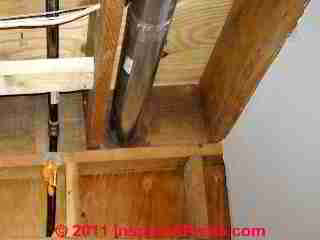 Clothes Dryer Temperature Test Conditions: exhaust vent
Clothes Dryer Temperature Test Conditions: exhaust vent
The standard-diameter 4-inch clothes dryer exhaust vent materials are all solid-metal. During installation of this vent we excluded screws that might protrude into the vent interior and we taped its joints with foil tape. The total vent length is approximately 16 ft. and involves 4 90 degree elbows.
At this installation the clothes dryer vent passage and conditions are described as follows:
- extends from the bottom of the dryer through an interior partition wall (about 6" total thickness including framing and drywall),
- passes through a 90 degree elbow
- extends upwards 7ft 6in on the exterior of a utility room wall (utility room interior temperature about 80 deg)
- passes through a second 90 degree elbow to re-enter the wall, a third and fourth elbow to pass up, then horizontally through the ceiling of the laundry room
- extends 8 ft. 2" horizontally passing straight through the interior of the insulated (open cell foam) laundry room ceiling
- passes through the building's exterior wall at the rim joist (about 6" total thickness) to the exterior where a plastic louvered vent cover is mounted. provided by the manufacturer: this component causes rapid lint-clogging of the vent system.
- The vent screen had been previously cleared of any blocking lint.
- The dryer vent had been in light use approximately 14 months and sported a thin coating (1/16-1/8") of lint.
The laundry room ceiling (item 5 above) is framed with 2x10 lumber, insulated with 9 1/2" of open celled spray foam. The dryer vent passes through this space.
Photo above: the clothes dryer vent passage through the laundry room ceiling before insulation was installed.
Photo below: normal lint accumulation in the clothes dryer vent system after six months of moderate usage.
The dryer vent screen installed on this dryer vent system is discussed at CLOTHES DRYER VENT TERMINATION & SCREENS
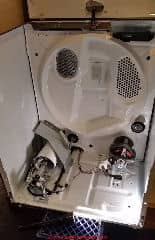 Accuracy of Measurements of Clothes Dryer Temperature
Accuracy of Measurements of Clothes Dryer Temperature
Photo: interior of the tested Maytag LP gas fueled clothes dryer during conversion of the dryer from natural gas (factory set-up) to LP gas (field conversion). The tumbler drum, drive belt, and other components have been removed to give view of and access to the gas heating unit in the dryer. [Click to enlarge any image]
It is important when measuring temperatures in a gas fired clothes dryer system to note when the gas burner has cycled -on . The burner in this gas dryer model is not on continuously as the dryer spins. Rather the burner is turned on and off to keep the dryer within a set-temperature range as the dryer operates. It's easy to know when the gas burner is on:
- You will hear the burner cycling on and off
- During temperature measurement at a fixed location temperature will rise to a stable high when the burner is on and will fall to a fairly stable low when the burner is off.
Because the IR scanner is measuring the surface temperature the emissivity of the particular surface or conditions that effect its emissivity have an effect on the accuracy of the measurement.
For more accurate results, Exergen recommends that the user apply a black crayon or marker to a spot of a size larger than the area being measured by the scanner. I used this method only where the black spot would not cause complaints from the homeowner - that is, inside of a utility room at the dryer vent duct near the bottom of the dryer. Other locations such as the dryer interior were not blackened.
The result of measurements of a surface that was not blackened, when measuring dryer or dryer duct metal surfaces in the dryer's operating temperature range between 120 - 150°F (49 - 66°C) I observed readings that were usually 7-12°F lower than on blackened high-emissivity surfaces.
I think that the temperature sensor's close proximity to the vent interior surface and dark colour of the interior of the dryer exhaust vent (lint-coated with gray lint) may have made those measurements more-accurate.
More-scholarly and accurate clothes dryer temperature measurements using direct-contact temperature sensing devices were performed by Bonaccorso (2012) cited at CLOTHES DRYER FIRE RESEARCH.
Conclusions
The gas fired residential clothes dryer actual field-installation measurements made at a single dryer during hot weather in New York in July, 2017 produced results similar to the theoretical and laboratory results and conclusions of Bonaccorso et als (2012) and other experts. All of the temperatures remained well below the recommended maximum temperature inside the clothes dryer of 200 °C (392 °F).
One surprise is worth further investigation: the clothes dryer vent temperatures just inside the dryer vent at its exterior wall outlet were considerably higher 143 °F (62 °C) than even the temperatures measured at the dryer vent near the point of connection of the vent system to the clothes dryer where we found an outlet temperature of 123 °F (51 °C).
It seems possible that high temperatures in the flat-roof/ceiling cavity develop during sunny July weather at this building. The roof is covered with black EPDM rubber and has surface temperatures on hot sunny days ranging between 120 - 150°F (49 - 66°C) or higher. Longer periods of direct sun will produce higher temperatures on the roof surface.
I suspect that high roof temperatures contributed to the high clothes dryer vent temperatures measured at the wall exhaust. Below is an example roof surface temperature made after about 30 minutes of direct sunlight at the roof area in question.
Clothes dryer temperature & venting safety standards might consider the possible effects of the surrounding environment if the dryer vent passes through very hot spaces.
Also see DEFINITION of HEAT FLOW DIRECTION
Clothes Dryer Exhaust Vent Installation, Dryer Temperatures, Dryer Fires Research
Citations mentioned in this article as well as additional clothes dryer operation, temperature, fire hazard research material has moved to CLOTHES DRYER FIRE RESEARCH
...
Continue reading at CLOTHES DRYER SAFETY CHECKLIST or select a topic from the closely-related articles below, or see the complete ARTICLE INDEX.
Or see these
Recommended Articles
- CLOTHES DRYER INSTALLATION & REPAIR - home
- CLOTHES DRYER ASBESTOS
- CLOTHES DRYER FIRE HAZARD WARNINGS
- CLOTHES DRYER FIRE RESEARCH
- CLOTHES DRYER LINT FILTER HAZARDS
- CLOTHES DRYER LINT CLOG RESISTANT SCREENS
- CLOTHES DRYER SAFETY CHECKLIST
- CLOTHES DRYER TEMPERATURES
- CLOTHES DRYER TEMPERATURE MEASUREMENTS
- CLOTHES DRYER VENTING - home
Suggested citation for this web page
CLOTHES DRYER TEMPERATURE MEASUREMENTS at InspectApedia.com - online encyclopedia of building & environmental inspection, testing, diagnosis, repair, & problem prevention advice.
Or see this
INDEX to RELATED ARTICLES: ARTICLE INDEX to APPLIANCE REPAIR
Or use the SEARCH BOX found below to Ask a Question or Search InspectApedia
Ask a Question or Search InspectApedia
Questions & Answers on bathroom vent fan and fan ducting installation procedures, codes, standards.
Try the search box just below, or if you prefer, post a question or comment in the Comments box below and we will respond promptly.
Search the InspectApedia website
Note: appearance of your Comment below may be delayed: if your comment contains an image, photograph, web link, or text that looks to the software as if it might be a web link, your posting will appear after it has been approved by a moderator. Apologies for the delay.
Only one image can be added per comment but you can post as many comments, and therefore images, as you like.
You will not receive a notification when a response to your question has been posted.
Please bookmark this page to make it easy for you to check back for our response.
Our Comment Box is provided by Countable Web Productions countable.ca
Citations & References
In addition to any citations in the article above, a full list is available on request.
- [7] "Healthy Indoor Air for America's Homes, Indoor Air Hazards Every Homeowner Should Know About - room by room assessment", U.S. Government Publications, web search, 11/30/2011, original source: http://publications.usa.gov/epublications/indoorair-hazards/assessment.htm More about this information source, quoting the US Government website:
... Federal Citizen Information Center (FCIC) has been a trusted one-stop source for answers to questions about consumer problems and government services. FCIC, part of the General Services Administration's Office of Citizen Services and Innovative Technologies, has traditionally provided publications to consumers via the publications distribution center in Pueblo, Colorado. The Pueblo.GSA.gov website was where consumers could go to find information and order publications on a variety of topics from the federal government.
Publications.USA.gov replaces the former Pueblo.GSA.gov. - [8] "The Facts About Clothes Dryer Exhaust Systems", John Cranor, the ASHI Reporter, April 2005,American Society of Home Inspectors,® Inc., 932 Lee Street, Suite 101, Des Plaines, Illinois, 60016, Tel: 847-759-2820, website: ashi.org, original source: ashireporter.org/articles/articles.aspx?id=161
- [9] Tjernlund Residential Capacity Dryer Duct Booster®, "Dryer Duct Booster Fan Model LB1, Installation Instructions" [PDF], Tjernlund Products, 1601 9th Street
White Bear Lake, MN 55110-6794 , (800) 255-4208, web search 01/06/2012, original source: tjernlund.com/dryer_booster.htm Quoting:
The Dryer Duct Booster®, Model LB1, has been specifically designed to boost residential capacity clothes dryer duct exhaust velocities where dryer duct runs exceed 25 equivalent feet. Proper exhaust velocities will reduce drying times, save energy and prevent lint buildup in the dryer duct. The LB1 is controlled by an electronic Pressure Response Control (PRC) for automatic operation. The LB1 utilizes galvanized steel construction, a reverse inclined, particulate handling impeller that is guaranteed not to clog with lint and an externally mounted PSC motor for trouble-free operation. - In addition to citations & references found in this article, see the research citations given at the end of the related articles found at our suggested
CONTINUE READING or RECOMMENDED ARTICLES.
- Carson, Dunlop & Associates Ltd., 120 Carlton Street Suite 407, Toronto ON M5A 4K2. Tel: (416) 964-9415 1-800-268-7070 Email: info@carsondunlop.com. Alan Carson is a past president of ASHI, the American Society of Home Inspectors.
Thanks to Alan Carson and Bob Dunlop, for permission for InspectAPedia to use text excerpts from The HOME REFERENCE BOOK - the Encyclopedia of Homes and to use illustrations from The ILLUSTRATED HOME .
Carson Dunlop Associates provides extensive home inspection education and report writing material. In gratitude we provide links to tsome Carson Dunlop Associates products and services.


